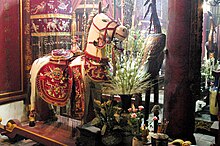Popular piety

In general, popular piety is understood as the visible expression of religiosity among the lay people of a regional religious community . It is made up of the “official” liturgy (totality of religious ceremonies and rites ) and traditional customs which are associated with religion in “good faith”. The (possibly pagan ) origins of such cult acts are no longer present. The unclear term popular religion is sometimes used synonymously.
From the theological point of view, popular piety is only used to describe religiously motivated acts that are not legitimized by the scriptures , but which are also not viewed as superstition or heresy . Contrary to popular belief , they are tolerated or integrated, but not encouraged.
The popular devotion is part of the popular beliefs . These two terms are (especially in German folklore ) often not sharply delimited from one another and used synonymously. In contrast, the latter is specifically related to the “spiritual superstructure” of religious and spiritual beliefs.
Pronounced popular piety with many syncretistically mixed elements from ethnic religions can be found in the Catholic regions of Sub-Saharan Africa and Latin America as well as in the Orthodox regions of Eastern Europe and Asia.
Forms of expression





Popular piety speaks to the subjective feeling more than the understanding. She is often expressed in expressive, expressive forms and works with a variety of symbols. Lived and official piety were often in opposition. In inculturation processes , for example in the context of missionary work , this official worship service must be open to religious forms of expression that correspond to the respective national character and seek to integrate them. It would be a mistake to construct a contradiction between the "ambiguous religiosity of the many" and the "true faith"; rather, the piety of the people shows the “diverse and inculturated communicability of faith”, as the religious scholar Diego Irarrázaval puts it.
The following things and expressions are typical of popular piety outside the liturgy:
- Use of sacrificial candles (Christianity), amulets and incense sticks (Far Eastern religions)
- A variety of devotional objects (devotional items )
- Votive offerings
- Cult and grace images , worship of relics
- Holy places
- Pilgrimages
Religious studies background
In 1750 the Enlightenment scientist David Hume designed a “two-tier model” based on religious studies , according to which there would always be a “religion of the common people” and an “elite religion” in monotheism . While the elite - the theologians and the clergy - fully understand the doctrine and try to preserve it, there would be a tendency towards (hidden) polytheism among the people (example: frenetic worship of saints in Catholicism). Johann Gottfried Herder developed the concept of a “people's personality” with a naturally creative “people's soul”, which he viewed as the opposite of the upper-class educational knowledge.
According to folklorist Wolfgang Brückner , the term “popular piety” is “a late, technical-language construct with ambivalent evaluation possibilities” ; the scientific use is controversial, the connotations ambiguous. It only emerged from the middle of the 20th century; the Grimm dictionary in its 1951 edition did not yet know it.
Causes of emergence
Popular piety often arises from the practical way in which believing lay people deal with their faith. They are often not or only partially aware of the tradition of intellectual discussion within faith ( theology ). This can also result in something new and new in the exercise of faith.
Regional influences, influences from other religions ( syncretism ) and rites as well as the zeitgeist expand festivals and customs . They thus offer a valuable contribution to the understanding of a regional culture . The number of “foreign religious” elements in popular piety varies greatly from region to region (even within a people) and depends on ethnic mixes and historical-syncretistic influences from repressed or forbidden religions.
Christianity
Catholicism
In Catholicism , a variety of popular piety has developed, especially in the area of Mary - Angel - and the veneration of saints . It stands in a reciprocal relationship to the essentially higher liturgy, which is "its most important source and its breeding ground", says Andreas Heinz . Since the inculturation of the harsh urban Roman liturgy in the Franconian region in the form of the Gallican liturgy at the beginning of the Middle Ages, popular, more sensual celebration elements such as processions , liturgical games and the veneration of saints have been formed, which supplemented the official liturgy and were partially included in it. In individual cases forms of piety can also have a destructive effect on the liturgy. However, one-sidedness and excesses are criticized by the teaching office and sometimes condemned as heresy .
There are a number of ambivalences between officially regulated theology and liturgy and the tendencies of popular piety, which the pastoral theologian Ernest Henau sees in the following areas:
- Separation between the profane and the sacred with a tendency towards sacred places and sacred objects
- Emphasis on personal salvation at the expense of the “political” dimension of faith
- the attempt to influence God through incantations, symbols and rites
- Tension between habit as a mark of popular piety and personal belief
- Predominance of feeling.
According to Henau, the aim of pastoral care should be to strengthen the elements of trust and coexistence in a valuable tradition that offers identity and security; In this way, the incarnational , bodily character of the Christian faith can be experienced and a certainty conveyed that salvation encompasses the whole person and includes a culture of feelings.
The Second Vatican Council coined the term “ pious exercises of the Christian people” ( Pia exercitia ) for the elements of liturgical popular piety, provided they correspond to the rules and regulations of the Church . It recommended these devotional exercises and saw them arranged in relation to the liturgical celebration of the Paschal mystery in Holy Mass and the Liturgy of the Hours , from which they are derived and to which they "lead the people, since by their nature they are far above them" ( SC 13). Religious exercises are in a sense an “echo of what is celebrated in the liturgical process”.
The frequent "pious exercises" widespread in Central European Catholicism include processions , especially the Corpus Christi procession and corridor processions , pilgrimages , the rosary , the prayer of the Way of the Cross and the Angel of the Lord , eternal adoration and novenas . Church festivals in the annual cycle are followed by local customs such as cutting Barbara branches , carol singers , Sacred Heart fire , healing instructions or trips to the sanctuary , harvest festival and Martinssingen . Elements of popular piety are holy water and sacrificial candles .
In other cultures, such as in Central and South America, Africa or Asia, popular forms such as sacred dance , ancestral cult , worship of Mother Earth and forms of cosmic religiosity are incorporated into worship and congregational activities. They combine syncretistically with the veneration of Mary or influence, as in the case of the cult of the “black Nazarene” in the Philippines , the piety of Christ as a practice to promote recovery and social advancement. The religious scholar Diego Irarrázaval points out the cultural connective meaning of these syncretisms, even if the forms require a critical distinction. By accepting the traditions of popular piety, religion shows that it addresses the needs of human beings, with which the evil and demonic are to be suppressed, and that it affirms the healing effect of common faith.
orthodoxy
While in the Latin Church of the West the bitter urban Roman liturgy was perceived as remote from the people and provoked the development of more sensual forms of celebration in addition to the official liturgy, the oriental liturgies succeeded in synthesizing such forms, so that extra-liturgical devotional exercises hardly developed.
Protestantism
The Protestantism that a return to the Scripture demanded of popular piety from the beginning was skeptical at. To a lesser extent, figurative and ritual forms of expression have also found space in his field and regional characteristics have developed.
Islam
In numerous Islamic countries, Orthodox Islam and popular Islam are opposed to one another, whereby according to classical Islamic jurisprudence, the popular religion is sometimes sharply criticized as syncretistic. Popular religious tendencies are widespread on the African continent .
In Islam, the saints are mostly Sufis (Islamic mystics ), whose graves are visited not only by followers of Sufism, but also by the general public. Mostly the Islamic saints are spiritual leaders ( Walis ) or founders ( Sheikh , Pir ) of a dervish order ( Tariqa ).
See also
literature
- Jakob Baumgartner (ed.): Rediscovery of popular religiosity. Pustet Verlag, Regensburg 1979, ISBN 978-3-7917-0581-1 .
- Wolfgang Brückner , Andreas Heinz , Ernest Henau, Diego Irarrázaval : Popular piety . In: Walter Kasper (Ed.): Lexicon for Theology and Church . 3. Edition. tape 10 . Herder, Freiburg im Breisgau 2001, Sp. 858-862 .
- Adam Yuet Chau: The Politics of Legitimation and the Revival of Popular Religion in Shaanbei, North-Central China. In: Modern China. Vol. 31, No. 2, 2005, pp. 236-278, doi : 10.1177 / 0097700404274038 .
- Adolf Exeler , Norbert Mette : Theology of the people. Mainz 1978.
- Karl Hoheisel , Susanne Galley , Andreas Merkt , Hans-Dieter Döpmann : Popular piety . In: Theologische Realenzyklopädie (TRE). Volume 35, de Gruyter, Berlin / New York 2003, ISBN 3-11-017781-1 , pp. 214–248.
- Andreas Holzem : "Popular Piety". To say goodbye to a term. In: Theological quarterly . Vol. 182, No. 3, 2002, pp. 258-270.
- Rudolf Kriss , Hubert Kriss-Heinrich: Popular belief in the area of Islam. 2 volumes (volume 1: pilgrimage and veneration of saints. Volume 2: amulets, magic formulas and incantations. ). Harrassowitz, Wiesbaden 1960–1962.
- Hans-Jürgen Prien : Popular piety in Latin America. Considerations from church history. In: Hans-Jürgen Prien: The Gospel in the Occident and in the New World. Studies on theology, society and history (= Acta Coloniensia. Vol. 5). Edited by Hans-Martin Barth and Michael Zeuske on the author's 65th birthday . Vervuert, Frankfurt am Main 2000, ISBN 3-89354-195-0 , p. 399 ff.
- Martin Radermacher: Popular piety in the guise of modern esotericism? Problematisation of ethnological and religious studies concept fields. In: Anja Schöne, Helmut Groschwitz (Ed.): Religiosity and Spirituality. Questions, competencies, results. Waxmann, Münster et al. 2014, ISBN 978-3-8309-3061-7 , pp. 387-403.
- Martin Scharfe : About religion. Faith and Doubt in Popular Culture. Böhlau, Cologne et al. 2004, ISBN 3-412-07504-3 .
- Jun Shimoda: Popular religion and authority in modern Germany. Pilgrimages or German Catholicism. Ozorasha, Tokyo 2004, ISBN 4-283-00146-5 (also: Tokyo, University, dissertation, 1999).
- Maria Widl : popular piety. In: Harald Baer, Hans Gasper, Joachim Müller, Johannes Sinabell (eds.): Lexicon of new religious groups, scenes and world views. Orientations in religious pluralism. Completely revised edition. Herder, Freiburg (Breisgau) et al. 2005, ISBN 3-451-28256-9 , pp. 1356-1360.
Web links
- Paul Hugger: popular piety. In: Historical Lexicon of Switzerland .
Individual evidence
- ↑ Peter-Matthias Gaede (Ed.): GEO Subject Lexicon: Religions - Faith, Rites, Holy Vol. 16, Gruner + Jahr, Bibliographisches Institut, Mannheim 2007. ISBN 978-3-7653-9436-2 . P. 802, key words “popular piety” and “popular belief”.
- ↑ Karl R. Wernhart : Ethnic Religions - Universal Elements of the Religious. Topos, Kevelaer 2004, ISBN 3-7867-8545-7 . P. 140.
- ↑ a b c Berthold Budde, Christine Laue-Bothen: Harenberg Lexicon of Religions. The religions and denominations of the world. Their meaning in history, everyday life and society. Harenberg, Dortmund 2002, ISBN 3-611-01060-X . P. 259.
- ^ Paul Hugger: Popular Piety. In: Historical Lexicon of Switzerland . December 27, 2014 , accessed April 29, 2016 .
- ^ Andreas Heinz: Popular piety. II. Liturgical . In: Walter Kasper (Ed.): Lexicon for Theology and Church . 3. Edition. tape 10 . Herder, Freiburg im Breisgau 2001, Sp. 859 .
- ^ Diego Irarrázaval: Popular piety. IV. Young churches . In: Walter Kasper (Ed.): Lexicon for Theology and Church . 3. Edition. tape 10 y860ff. Herder, Freiburg im Breisgau.
- ^ Wolfgang Brückner: Popular piety. I. Conceptual history. In: Walter Kasper (Ed.): Lexicon for Theology and Church . 3. Edition. tape 10 . Herder, Freiburg im Breisgau 2001, Sp. 858 f .
- ^ Wolfgang Brückner: Popular piety. I. Conceptual history . In: Walter Kasper (Ed.): Lexicon for Theology and Church . 3. Edition. tape 10 . Herder, Freiburg im Breisgau 2001, Sp. 858 .
- ↑ The big Brockhaus. 21st, completely revised edition, FA Brockhaus, Leipzig / Mannheim 2006. ISBN 3765341452 , vol. 29, p. 203 - keyword “popular piety”, p. 204 - keyword “popular belief”.
- ^ Andreas Heinz: Popular piety. II. Liturgical . In: Walter Kasper (Ed.): Lexicon for Theology and Church . 3. Edition. tape 10 . Herder, Freiburg im Breisgau 2001, Sp. 859 .
- ^ Ernest Henau: popular piety. III. Practically theological . In: Walter Kasper (Ed.): Lexicon for Theology and Church . 3. Edition. tape 10 . Herder, Freiburg im Breisgau 2001, Sp. 860 .
- ^ Constitution on the Sacred Liturgy Sacrosanctum Concilium , 13; see. also Dogmatic Constitution on the Church Lumen Gentium , 67.
- ^ Congregation for Divine Worship and the Order of the Sacraments: Directory on Popular Piety and the Liturgy , 2001, No. 13.
- ^ Diego Irarrázaval: Popular piety. IV. Young churches . In: Walter Kasper (Ed.): Lexicon for Theology and Church . 3. Edition. tape 10 y860ff. Herder, Freiburg im Breisgau.
- ^ Andreas Heinz: Popular piety. II. Liturgical . In: Walter Kasper (Ed.): Lexicon for Theology and Church . 3. Edition. tape 10 . Herder, Freiburg im Breisgau 2001, Sp. 859 .
